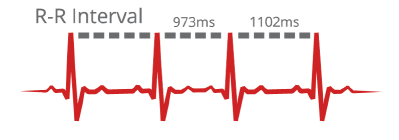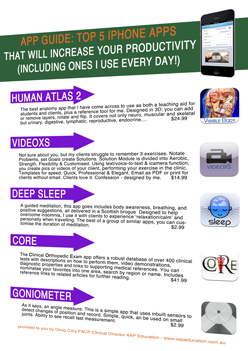 As you may know I have been interested in heart rate variability (HRV) for several years and first presented some concepts in relation to using acupuncture to positively influence the autonomic nervous system at the 2013 APA Conference in Melbourne. At that stage to purchase a monitor enabling HRV measurement, meant spending $10,000+; outside the range of most physiotherapy practices! Fast-forward a few years and with an appropriate Bluetooth transmitter plus smartphone app, you are setup for under $100. As you may know I have been interested in heart rate variability (HRV) for several years and first presented some concepts in relation to using acupuncture to positively influence the autonomic nervous system at the 2013 APA Conference in Melbourne. At that stage to purchase a monitor enabling HRV measurement, meant spending $10,000+; outside the range of most physiotherapy practices! Fast-forward a few years and with an appropriate Bluetooth transmitter plus smartphone app, you are setup for under $100.
So what is HRV?
Fluctuations in time between heartbeats, specifically the 'R' part of the QRS complex, is called heart rate variability or (HRV). Previous monitors averaged your heart rate - so it would say 60 beats per minute (bpm) and then remeasure again a few seconds later. However, in reality the time between each subsequent 'R' portion of the QRS complex will have been different. So your true heart rate may have been 59.06 bpm, 59.5 bpm, 60.2 bpm and 60.8 bpm for example. Not exactly falling on 60 bpm. With improvements in technology we are now able to accurately measeure thiese millisecond variations. Having a higher HRV, means a larger variation in bpm, and this turns out to be a reliable indicator of health and general resilience to stress (6).
What’s the interest in HRV?
Well, the interest in HRV is measuring the clinical importance of the autonomic nervous system function. In the physical domain, reduced HRV is a powerful and independent predictor of an adverse prognosis in patients with heart & lung disease; hypertension (1), chronic heart failure, sudden cardiac death (4) and respiratory disorders like COPD (3) or asthma, and also in the general population. In the psychological domain, reduced HRV has important functional significance linked with depression (5), anxiety (2) anger, motivation to engage in social situations, social approach behaviors, self-regulation and psychological flexibility in the face of stressors.
This psychological flexibility is one of the many aspects that intrigue me about HRV. Two paraphrases that I use with clients frequently are Einstein’s definition on insanity - expect a different outcome, while changing nothing and the psychological experiment of delayed gratification - where young children are offered a sweat now or if they wait a period of time, they will receive significantly more sweats and then following them over 30 years to see how they progressed in life. You are no doubt familiar with them both.
In relation to HRV, using the first example I explain that we are governed by habits. Maybe we inherited them, picked them up socially or deliberately modeled ourselves on others. Regardless, habits happen and we are largely unaware of them. We brush our teeth starting on the same tooth, we place the same foot into trousers first each time, we look left, right, left and then cross the street, we think of our PIN number before handing over our credit card. The thing is, this is lessening the chance of variation, minimising possible stress encounters and all about maintaining our comfort zones. This being the case when something does trip us up, how is our recovery, our resilience, our adaptability?
So I am hunting for ways to challenge my comfort zones and increase my HRV. Actions (physical) or thoughts (mental) that have become habits are targets, and this in some way I aim to challenge these boundaries. It is the mental ones that I find really interesting. Why? Well, this goes to the second paraphrase. How confident are we with our mental will power, our willingness to delay benefit beyond the immediate, or make a decision and follow it through?
My current challenge is cold showers Tuesday, Thursday and Saturday for 6 months. Sounds simple, but it has been so interesting to sit mentally on the side and observe my brain’s dilemma. Logically cold is just a sensory experience, no short or longer-term damage, possible short (less water used) and longer-term benefits (search Mammalian Diving Reflex, stimulation PNS). Yet ...... it is uncomfortable (several mornings have been 6 C) ...... and how my brain tried to contrive reasons to avoid, delay a shower or turn on the hot tap. I even found myself once putting my hand into the shower to check the water temperature - da - it was cold!
Now going into my 4th month, I have decided to continue through winter till September. The two constants are my clients still think I am crazy and the cold water is still cold. However my brain has accepted this is the status quo and no longer figits with the idea of having a cold shower. My body now also seems to enjoy the sensation. A bit like exercise, you really feel great when you stop.
What is your challenge?
You might be unphased by cold showers. Probably your challenge will be different. Perhaps over a three month period you could;
- Not drink coffee, tea or alcohol
- Say hello to 3 strangers a day
- Not consume high sugar foods; sweats, cakes, biscuits, carbonated or flavored milk drinks
- Exercise 3 times a week for 60 minutes
- Finish work at 5 and be home reading a story to your children 3 nights a week
For me the interesting thing was to identify a habit, decide there is a better or alternative way to approach the habit, make the decision to change the habit and stick by it. I don’t think the habit really matters, the internal strength/resilience gain is in making the decision and staying the course. Improving a poor habit is an added bonus.
References
1. Elliott WJ, Izzo JL, White WB, Rosing DR, Snyder CS, Alter A, Gavish B, and Black HR. Graded blood pressure reduction in hypertensive outpatients associated with use of a device to assist with slow breathing. The Journal of Clinical Hypertension 6: 553-559, 2004.
2. Friedman BH. An autonomic flexibility–neurovisceral integration model of anxiety and cardiac vagal tone. Biological psychology 74: 185-199, 2007.
3. Giardino ND, Chan L, and Borson S. Combined heart rate variability and pulse oximetry biofeedback for chronic obstructive pulmonary disease: preliminary findings. Appl Psychophysiol Biofeedback 29: 121-133, 2004.
4. Goldberger AL. Is the normal heartbeat chaotic or homeostatic? Physiology 6: 87-91, 1991.
5. Nahshoni E, Aravot D, Aizenberg D, Sigler M, Zalsman G, Strasberg B, Imbar S, Adler E, and Weizman A. Heart rate variability in patients with major depression. Psychosomatics 45: 129-134, 2004.
6. Wheat A, and Larkin K. Biofeedback of Heart Rate Variability and Related Physiology: A Critical Review. Appl Psychophysiol Biofeedback 35: 229-242, 2010.
All the best,
Doug Cary FACP
Specialist Musculoskeletal Physiotherapist (awarded by Australian College of Physiotherapy, 2009)
PhD Candidate Curtin University
Clinical Director AAP Education
email: doug@aapeducation.com.au
ph/fx: 08 90715055
Receive a FREE Information Report

Choose The Top 5 Manual Therapy Apps or Infection Control & Needling (V2)
Along with the report you'll also get a complimentary subscription to "Clinical Kit" our regular eZine (email newsletter) and Free Bronze Membership. You'll get ideas, information, insight and inspiration on a regular basis, plus access to our Resource Library, helping you unravel those clinical conundrums appearing every day.
You are free to use material from the Blog in whole or in part, as long as you include complete attribution, including live website link. Please also notify me where the material will appear. The attribution should read: "By Doug Cary FACP of AAP Education. Please visit our website at www.aapeducation.com.au for additional clinical articles and resources on post graduate education for health professionals" (Please make sure the link is live if placed in an eZine or in a web site.)
HOME | DRY NEEDLING PROGRAM | CERVICAL SPINE | FASCIAL MANIPULATION | MULLIGANS | MSK & RT ULTRASOUND | NEURODYNAMIC SOLUTIONS | THE SHOULDER | VESTIBULAR PROGRAM | LIVING ANATOMY WET LABS | BLOG
   
|

